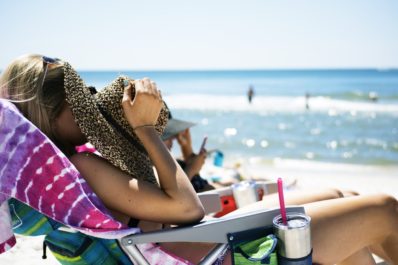Sunscreens that are good for your skin AND the ocean
At Revolution, we’re passionate about making a positive impact on the environment. Since summer is in full swing, it means we’re spending time outside in the sun swimming, hiking, happy hour-ing and more. It also means we’re applying and reapplying sunscreen constantly.

At Revolution, we’re passionate about making a positive impact on the environment. Since summer is in full swing, it means we’re spending time outside in the sun swimming, hiking, happy hour-ing and more. It also means we’re applying and reapplying sunscreen constantly.
According to the Environmental Working Group (one of our favorite resources for choosing safe, non-toxic products), the most common sunscreens on the market contain chemical filters. These products typically include a combination of two to six of the following active ingredients: oxybenzone, avobenzone, octisalate, octocrylene, homosalate, and octinoxate.
A recent study revealed that common sunscreen ingredients oxybenzone and octinoxate have proven to be toxic to living coral. “While there are several known disruptors of coral and marine life, many of which are banned from eco-marine reserves, UV-protective oxybenzone, which also goes by benzophenone-3 and BP-3, has been under increased scrutiny since the Archives of Environmental Contamination and Toxicology published a paper in 2015 that reveals it as a genotoxicant for coral, meaning that it causes destructive mutations at a genetic level.”
In essence, chemical sunscreens serve to amplify one of the worst effects of climate change in the sea: The primary cause of coral bleaching is rising sea temperatures, but oxybenzone, which becomes more toxic when exposed to sunlight, contributes to that bleaching while introducing other issues to the coral—DNA damage and death among them. “Eighty-five percent of Caribbean reefs have disappeared in the past 50 years,” says Dr. Craig Downs, lead author on the 2015 paper and executive director of nonprofit Haereticus Environmental Laboratory.
Organizations like the Safe Sunscreen Council – a group of 11 brands that care about their impact on our health and the environment make it easier than ever to choose a sunscreen that is safe for you and safe for the planet.
A few of our favorite picks from the Safe Sunscreen Council include Raw Elements, a sunscreen that was developed by a lifeguard. After years of using harsh chemical sunscreens to meet the protection demands of an ocean lifeguard, founder Brian Guadagno set out to create a natural alternative that actually worked. He transformed his kitchen into a lab, researching and formulating until Raw Elements was born. His mission is to create products whose ingredients and performance can be trusted, allowing you to get out into the world and find your nature.
Manda’s SPF 50 Organic Sun Paste is specifically formulated for those weathering harsh outdoor conditions (like biking, swimming or surfing) or who are prone to sunburn. This paste features Thanaka, an anti-inflammatory and regenerative ingredient derived from trees native to Myanmar, which has been used for over 2000 years as a natural sun protectant.
Babo Botanicals’ Pretty & Protective Lip Tint Trio comes in three sustainable shades and will keep your lips smooth and safe for summer.
We also love Credo Beauty for their great selection of reef-safe sunscreens like Suntegrity.
What are your favorites?
